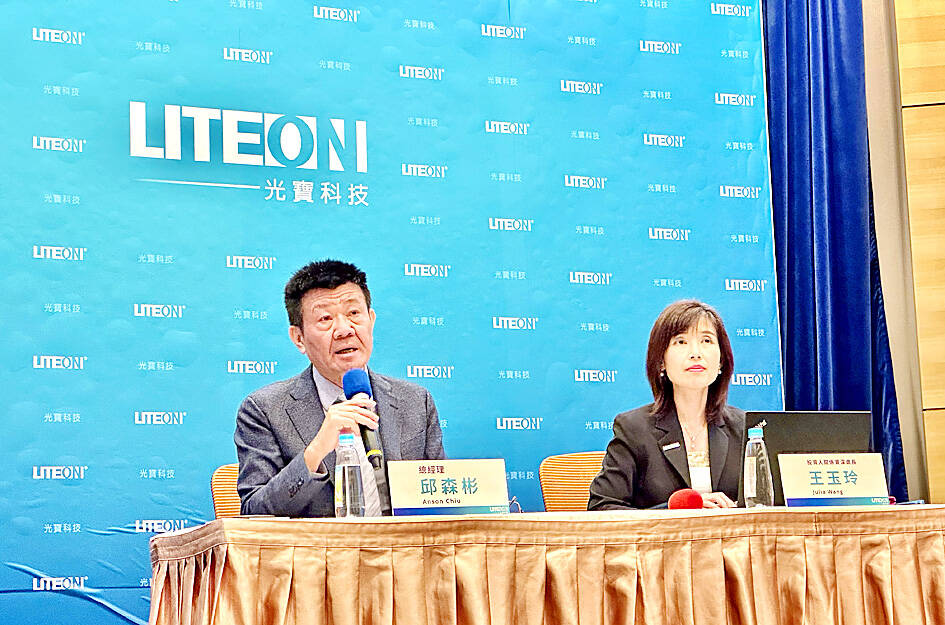Electronic components supplier Lite-On Technology Corp (光寶科技) posted the best quarterly net profit in its history last quarter at NT$4.56 billion (US$140.63 million), as gross margin improved thanks to an increase in shipments of better-margin power supplies for artificial intelligence (AI) servers and cloud-computing data centers, it said yesterday.
Last quarter’s net profit rose 9 percent sequentially from NT$4.2 billion, or 7 percent annually from NT$4.24 billion. Earnings per share rose to NT$1.99 last quarter from NT$1.84 in the second quarter and NT$1.86 last year.
That was despite the company’s revenue growth falling short of expectations as high inflation, geopolitical tensions and a weak macroeconomy dampened consumer spending during the quarter ending Sept. 30, Lite-On said.

Photo: Fang Wei-chieh, Taipei Times
Revenue last quarter experienced sub-seasonal growth, Lite-On said.
However, the firm’s gross margin grew to an all-time high of 23.6 percent last quarter from 23.3 percent a quarter earlier and 19.5 percent a year earlier, which it attributed to optimized product portfolios.
Lite-On’s operating profit margin improved to 11.6 percent from 9 percent in the second quarter and from 9.5 percent a year earlier.
The company said it expects revenue to grow at a mild pace this quarter, compared with NT$39.96 billion last quarter, as demand for components used in notebook computers and some consumer electronics started to pick up slightly.
“Business in the fourth quarter should be relatively lukewarm compared with the company’s records in the past,” Lite-On president Anson Chiu (邱森彬) told investors yesterday.
“Overall, we are relatively optimistic about the company’s ability to register a stable growth in revenue and profit during the fourth quarter, though the macroeconomic outlook remains bleak,” Chiu said.
This quarter’s main growth drivers would be high-margin power supplies used in cloud-computing servers and automotive devices, Chiu said.
US auto workers and automakers are resolving their conflicts and the supply of graphics processing units used in AI servers is improving, which would help fuel some demand this quarter, he added.
Demand for information and communications technology and consumer electronics have apparently bottomed out, Chiu said.
Notebook computer sales expanded year-on-year in the third quarter, while desktop computer sales would post an annual increase in the first quarter of next year, he added.
Lite-On expects revenue for this year to hold steady compared with last year, Chiu said.
Next year, the company is pushing for mergers and acquisitions to stimulate revenue growth, he added.
Lite-On said it is deploying two production lines in Dallas, Texas, which would contribute NT$2 billion in revenue next year, Chiu said.

STEEP DECLINE: Yesterday’s drop was the third-steepest in its history, the steepest being Monday’s drop in the wake of the tariff announcement on Wednesday last week Taiwanese stocks continued their heavy sell-off yesterday, as concerns over US tariffs and unwinding of leveraged bets weighed on the market. The benchmark TAIEX plunged 1,068.19 points, or 5.79 percent, to 17,391.76, notching the biggest drop among Asian peers as it hit a 15-month low. The decline came even after the government on late Tuesday authorized the NT$500 billion (US$15.2 billion) National Stabilization Fund (國安基金) to step in to buoy the market amid investors’ worries over tariffs imposed by US President Donald Trump. Yesterday’s decline was the third-steepest in its history, trailing only the declines of 2,065.87 points on Monday and

TAKING STOCK: A Taiwanese cookware firm in Vietnam urged customers to assess inventory or place orders early so shipments can reach the US while tariffs are paused Taiwanese businesses in Vietnam are exploring alternatives after the White House imposed a 46 percent import duty on Vietnamese goods, following US President Donald Trump’s announcement of “reciprocal” tariffs on the US’ trading partners. Lo Shih-liang (羅世良), chairman of Brico Industry Co (裕茂工業), a Taiwanese company that manufactures cast iron cookware and stove components in Vietnam, said that more than 40 percent of his business was tied to the US market, describing the constant US policy shifts as an emotional roller coaster. “I work during the day and stay up all night watching the news. I’ve been following US news until 3am

Six years ago, LVMH’s billionaire CEO Bernard Arnault and US President Donald Trump cut the blue ribbon on a factory in rural Texas that would make designer handbags for Louis Vuitton, one of the world’s best-known luxury brands. However, since the high-profile opening, the factory has faced a host of problems limiting production, 11 former Louis Vuitton employees said. The site has consistently ranked among the worst-performing for Louis Vuitton globally, “significantly” underperforming other facilities, said three former Louis Vuitton workers and a senior industry source, who cited internal rankings shared with staff. The plant’s problems — which have not

TARIFF CONCERNS: The chipmaker cited global uncertainty from US tariffs and a weakening economic outlook, but said its Singapore expansion remains on track Vanguard International Semiconductor Corp (世界先進), a foundry service provider specializing in producing power management and display driver chips, yesterday withdrew its full-year revenue projection of moderate growth for this year, as escalating US tariff tensions raised uncertainty and concern about a potential economic recession. The Hsinchu-based chipmaker in February said revenues this year would grow mildly from last year based on improving supply chain inventory levels and market demand. At the time, it also anticipated gradual quarter revenue growth. However, the US’ sweeping tariff policy has upended the industry’s supply chains and weakened economic prospects for the world economy, it said. “Now